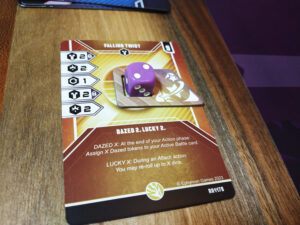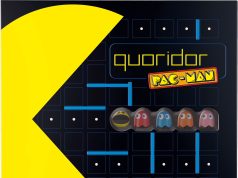 Airplanes, card-driven dogfights, simultaneous action selection, short play time… Those are just some of the things about this game that grabbed my attention. I was pumped to see how it would all work together and if it would live up to what sounded like an exciting experience.
Airplanes, card-driven dogfights, simultaneous action selection, short play time… Those are just some of the things about this game that grabbed my attention. I was pumped to see how it would all work together and if it would live up to what sounded like an exciting experience.
Aerodrome: Rising Horizons is a two-player aviation combat simulation game, playable in about an hour. Here’s what I thought of it.
Gameplay overview:
Each player chooses their plane/pilot and then assembles a hand of nine cards, numbered 1-9. The rulebook has a preset list of cards for each pilot if players don’t want to build their own hands. In addition, each player will assemble a small deck of auxiliary cards. Players also need to define a play area. This set includes a 14” x 24” play mat poster that can be used for this purpose. The two fighter tokens are then placed on opposite sides of the play area and players set their hit points dials to 15.

The game is played over several rounds, and each round is broken up into three phases: initiative phase, action phase, and end phase. During the initiative phase, players secretly select one of the cards from their hand. The player who plays the highest number gains the initiative. During the action phase, players carry out the actions depicted on the card. In addition to the numbers, cards also include an action bar, which indicates which actions this card can or must perform, and the order in which they are carried out. Cards might also include a keyword that can trigger various effects. The player with the highest initiative will carry out their actions to completion, then the other player will do the same. If no player has had their hit points reduced to zero at the end of a round, another round is played, and this is repeated until one player is defeated.
Actions are accomplished through the use of maneuver and shot tools. The actions you might find on a card are: Straight move, Turn, Rotate, Roll, Imelmann, and Shot. Actions also have a value associated with them, which will indicate the tool (in case of movement) or number of dice (in the case of attacks) to be used for that action. For example, a Straight 2 means players will use the “2” tool to determine how far their fighter moves. A Rotate with a value of two indicates the number of times the fighter token is rotated thirty degrees using a maneuver tool. A Shot 3 action means the attacker will roll 3 dice; any result of a 5 or 6 is considered a hit (some keywords can change the hit range). Each hit inflicts one damage on the defending fighter. There are also buffs and debuffs which can cause additional effects. When a fighter has zero life the game ends and the surviving fighter is the winner.

Gameplay Experience:
Aerodome: Rising Horizons sounded like it might be an “X-Wing lite” experience, with streamlined rules and a short playtime. The rulebook says a typical game will take 20-30 minutes, and I really liked the idea of a zippy aerial battle game that didn’t involve a bunch of minis and convoluted rules. Unfortunately, I found the listed playtime to be optimistic. Games easily last at least an hour, and most of that hour is spent tediously maneuvering your plane into attack range, only to have your opponent no longer be within attack range because they took the initiative.

Then, finally, when you do get your fighter into range, you get so excited that you forget for a second that you still need to roll dice to see if you score a hit! For an attack, you’ll roll anywhere from 1-4 dice, and any results of 5 or 6 are considered a hit. This results in many rolls being anticlimactic misses. And it will probably be a couple of rounds before you can maneuver back into an attack position again. On the other hand, sometimes your move does work out exactly how you hoped and you’re able to get off a really good hit, and if you have some status effects to go along with it, you might do serious damage, which does feel exciting.
On the topic of damage, the game includes four fighter types, each with its own strength, and I found that blue, which are strong attackers, tends to win more than the other colors. While I’m hesitant to question the balance of a game that has gone through careful design and rigorous playtesting (we hope!), I do suspect some balance issues here. Additionally, some planes simply seem to have better abilities than others. But since which fighter a player chooses isn’t really private information, players can attempt to balance this by choosing mutually agreed upon planes.

I also felt like some information was missing from the rulebook. For example, the rules concerning auxiliary decks and cards are vague and feel like an afterthought. The auxiliary cards themselves have almost no artwork, which made me question if I had a misprinted copy, but the same cards, void of any image, are also depicted in the rulebook. Thankfully the game did include a player aid with all the keywords because you will be checking that frequently. There are also little tedious rules, like rolling dice at the end of every round to see if an auxiliary token spawns, that are much too easily forgotten. The hand-building aspect is pretty fun and not too involved since you’re only choosing nine cards, and there’s a decent amount to choose from; or, as mentioned above, you can instead choose to use the pre-set hands, which is a good idea for your first couple games.
The use of the maneuver tools is pretty clean and makes sense, perhaps with the exception of turning which can be somewhat awkward. It’s easy to bump things or move them just a fraction, which sometimes might mean the difference between getting a hit in or not. I suspect a neoprene mat would help a great deal with this, but the copy I have only included a paper poster mat. Overall the use of the tools for maneuvering was slightly fiddly but generally fun, except for the fact that you rarely end up where you had hoped to, making some moves feel wasted, and that quickly starts to lose its charm by the second half of the game.
Final Thoughts:
I’m sure this game might be playable in 20 or 30 minutes… after you’ve played it 20 or 30 times. And honestly, there’s probably enough content in the box to support that. But to the average person who picks this box up with no prior knowledge of the game, hoping for a streamlined, easy-to-play aerial combat experience, I think Aerodome is going to fall flat. Many details are easy to forget and there are 19 different keywords to keep track of. It is fun sometimes, especially when things work out as you’d hoped, but I’m not exaggerating when I say that only happens about 50% of the time.
Final Score: 2.5 stars – A somewhat fun, but frustrating, exercise in tediousness.
 Hits:
Hits:
• Good amount of content in box
• Lower price point than miniatures games
• Fun half of the time
Misses:
• Outstays its welcome
• Odd lack of artwork
• Too finicky to be accessible





















